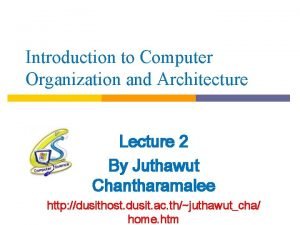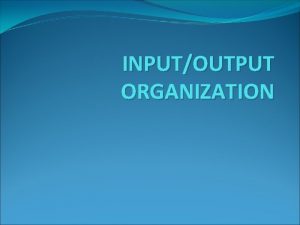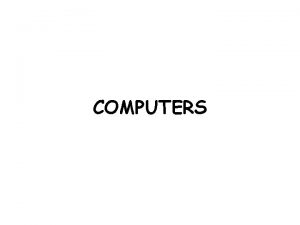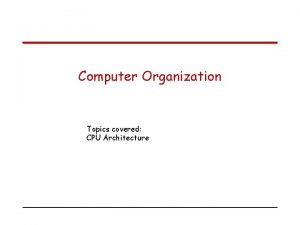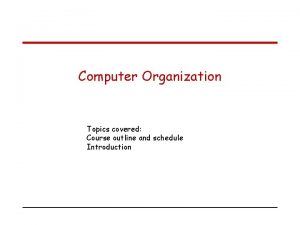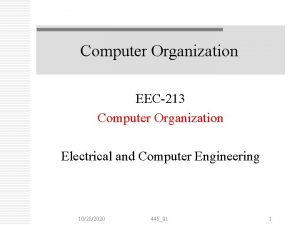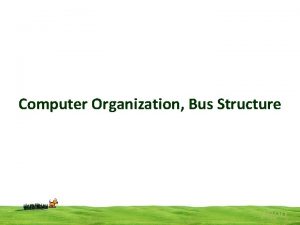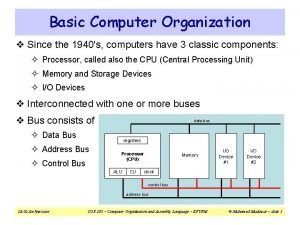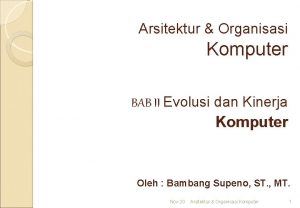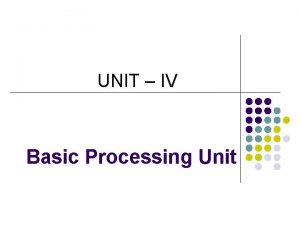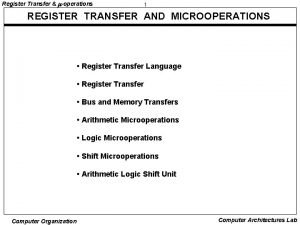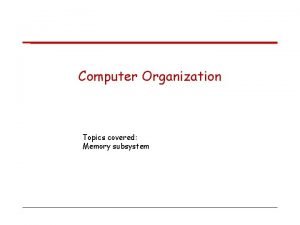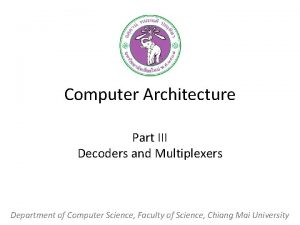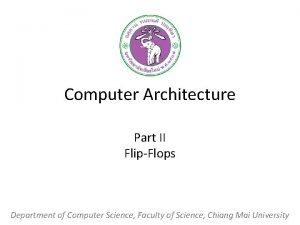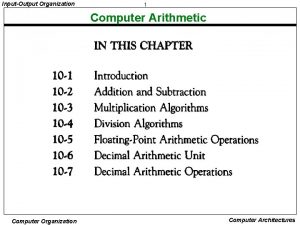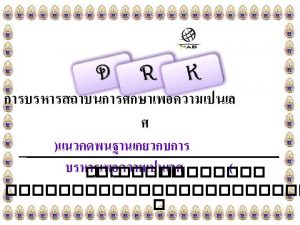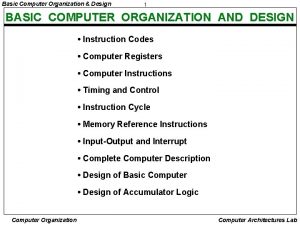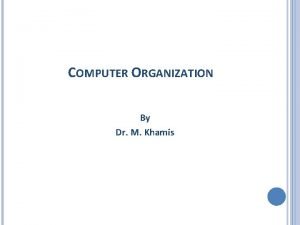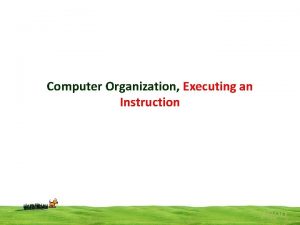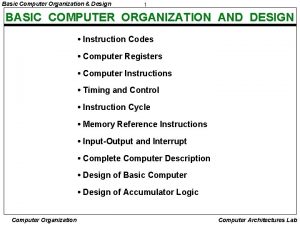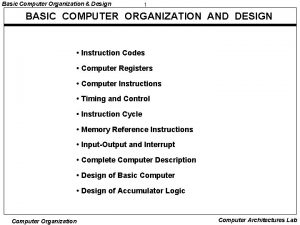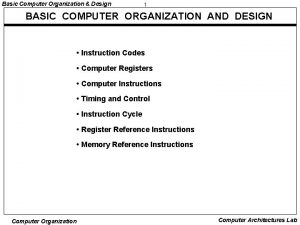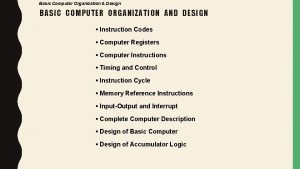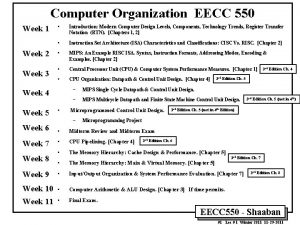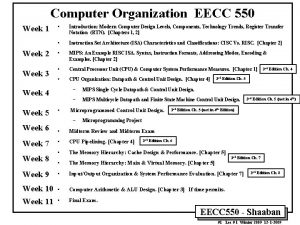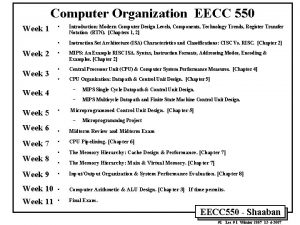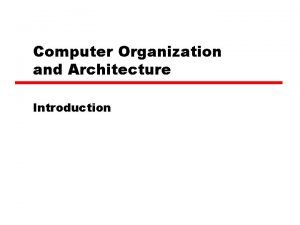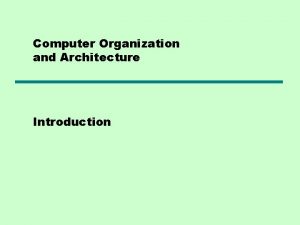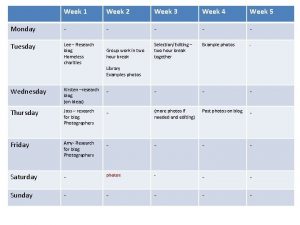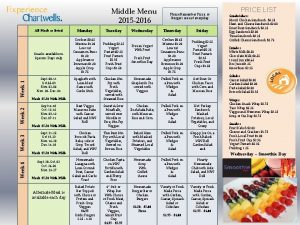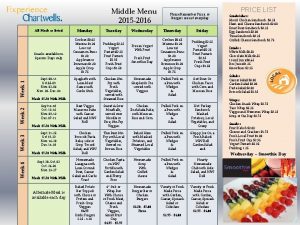CS 33 Introduction to Computer Organization Week 8





























- Slides: 29

CS 33: Introduction to Computer Organization Week 8 – Discussion Section Atefeh Sohrabizadeh atefehsz@cs. ucla. edu 11/22/19 1

Agenda ♦ ♦ Virtual Memory Threading and Basic Synchronization 2

Virtual Memory ♦ ♦ As demand on the CPU increases, processes slow down But, if processes need too much memory, some of them may not be able to run § When a program is out of space, it can’t run ♦ Solution: Virtual Memory (VM) § There is only one DRAM unit in machine § Provide each process with a large, uniform, and private address space so that they think they have access to entire DRAM § Main memory (DRAM) will be treated as a cache for an address space on disk § Memory management is simpler • Since each process has a uniform address space § Isolates address spaces • The address space of each process is protected from corruption by other 3

Virtual Memory (cont’) ♦ 4

DRAM Cache Organization ♦ ♦ DRAM is about 10 x slower than SRAM Disk is 10, 000 x slower than DRAM So, DRAM has huge miss penalty This results in: § Large page size § Fully associative • Any VP can be placed in any PP • But, with highly sophisticated replacement algorithms § Write back (rather than write through) 5

Page Table ♦ ♦ ♦ An array of page table entries (PTE) that maps virtual pages to physical pages Resides in DRAM Page hit: § Reference to VM word is in DRAM ♦ Page fault: § Reference to VM word is not in DRAM § Causes an exception § Page fault handler selects a victim to be evicted § Re-executes the current instruction 6

Using Page Table ♦ Split virtual address into VPN and VPO § VPN is used as an index to page table § If not valid: page fault ♦ Split physical address into PPN and PPO 7

Memory Management Unit (MMU) ♦ A chip in CPU that performs address translation § Virtual address to physical address ♦ Translation Lookaside Buffer (TLB) § Cache for MMU § Caches VPN translation to PPN § Typically has high associativity (e. g. 4 -way set associative) 8

TLB Hit and Miss 9

Example TLB T TLBI 10

CS 33: UCLA Address Translation Example #1 Virtual Address: 0 x 03 D 4 TLBT TLBI 13 12 11 10 9 8 7 6 5 4 3 2 1 0 0 0 1 1 0 1 0 0 VPN 0 x 0 F ___ 0 x 3 TLBI ___ VPO Y TLB Hit? __ 0 x 03 TLBT ____ N Page Fault? __ PPN: 0 x 0 D ____ Physical Address CI CT 11 10 9 8 7 6 5 4 3 2 1 0 0 0 1 1 0 1 0 0 PPN 0 CO ___ CO 0 x 5 CI___ 0 x 0 D CT ____ PPO Y Hit? __ 0 x 36 Byte: ____ 11

CS 33: UCLA Address Translation Example #2 Virtual Address: 0 x 0020 TLBT TLBI 13 12 11 10 9 8 7 6 5 4 3 2 1 0 0 0 0 0 1 0 0 0 VPN 0 x 00 ___ 0 TLBI ___ VPO N TLB Hit? __ 0 x 00 TLBT ____ N Page Fault? __ PPN: 0 x 28 ____ Physical Address CI CT 11 10 9 8 7 6 5 4 3 2 1 0 1 0 0 0 0 0 PPN 0 CO___ CO 0 x 8 CI___ 0 x 28 CT ____ PPO N Hit? __ Mem Byte: ____ 12

Multi-Level Page Table ♦ 13

CS 33: UCLA Sharing Revisited: Shared Objects Process 1 virtual memory Physical memory Process 2 virtual memory ¢ ¢ Process 1 and 2 maps the shared object. Notice how the virtual addresses can be different. 14

CS 33: UCLA Sharing Revisited: Private Copy-on-write (COW) Objects Process 1 virtual memory Physical memory Process 2 virtual memory Private copy-on-write area ¢ ¢ Imagine these are forked-processes Two processes mapping a private copy-on-write (COW) object. Area flagged as private copy-onwrite PTEs in COW areas are flagged as read-only 15

CS 33: UCLA Sharing Revisited: Private Copy-on-write (COW) Objects Process 1 virtual memory Physical memory Process 2 virtual memory ¢ Private copy-on-write area ¢ ¢ ¢ Instruction writing to COW page triggers protection fault. Handler creates new R/W page. Instruction restarts upon handler return. Copying deferred as long as possible! 16

Concurrency ♦ Motivation § Increase the performance by running multiple processes concurrently ♦ Approach: § Using processes • Pro • Address spaces are not shared • processes can’t overwrite VM of one another accidentally • Con • Address spaces are not shared • sharing information is hard • Tend to be slow because of large overheads for process control § Using threads 17

Thread-Based Concurrency ♦ Thread § “A logical flow that runs in the context of a process” ♦ ♦ ♦ Like processes, they are scheduled automatically by the kernel A single process can have multiple threads running concurrently All threads running in a process share the entire virtual address space § Easier communication ♦ Each thread has its own thread context § TID, stack pointer, program counter, general-purpose registers, and condition codes ♦ A thread context is much smaller than a process context 18

Thread Creation ♦ Create a thread using: § Use NULL for argument attr § When it returns, tid has the ID of the newly created thread ♦ A thread can determine its own ID using: ♦ A thread routine takes one argument as void* and returns one argument as void* as well 19

Thread Cleanup ♦ Threads can be terminated by § Calling either of the “pthread_exit”, “exit”, and “pthread_cancel” functions § Or when their top-level thread routine returns • Check book for more details ♦ Threads wait for other threads to terminate by calling pthread_join § Then they are reaped ♦ Joinable threads can be reaped and killed by other threads § To avoid memory leaks, each joinable thread should be either explicitly reaped by another thread or detached ♦ If you don’t plan on joining (reaping) make your threads detached § By calling pthread_detach 20

Progress Graph ♦ Models the execution of n concurrent threads § As a trajectory through n-dimensional Cartesian space ♦ Critical section § Instructions that manipulate a shared variable ♦ Unsafe region § Intersection of the two critical sections ♦ Safe trajectory § A trajectory that skirts the unsafe region § Ensures the mutually exclusive access to the shared variables ♦ Must synchronize threads so that they always have a safe trajectory 21

Semaphore ♦ All the process context excluding the thread context is shared § E. g. global and static local variables ♦ ♦ Shared variables may cause synchronization errors (One) Solution: § Use semaphores • A global variable with a nonnegative integer value • A counter that can get N values • A mutex is a binary semaphore (its value is always 0 or 1) • Associate a semaphore with each shared variable 22

Semaphore Functions ♦ int sem_init(sem_t *sem, 0, unsigned int value); § Initializes semaphore “sem” to value ♦ void P(sem_t *s); § “I want access” § Waits until s becomes nonzero § If s is nonzero, decrements s by one and returns immediately • Grabs the lock (locking the mutex) ♦ void V(sem_t *s); § “I’m done” § Increments s by one • Unlocks the mutex § If there any threads waiting at a P operation, wakes up one of them 23

Progress Graph with Semaphores ♦ ♦ Each state is labeled with the value of semaphore s Forbidden region § § § ♦ s<0 Encloses the unsafe region No feasible trajectory can include any of the states in the forbidden region § ♦ A collection of states made by combination of P and V operations Since semaphores should be nonnegative So every feasible trajectory is safe 24

Example ♦ What’s the problem with this code? § Deadlock • foo(n-1) can’t acquire the lock (mutex) • Since foo(n) is not done • gets stuck 25

Concurrency Issues ♦ Thread safety § A function is thread-safe iff always functions correctly when called repeatedly from multiple concurrent threads ♦ ♦ Carefully handle shared variables and use proper synchronization to achieve thread-safe function Reentrant functions § Special form of thread-safe functions § Does not use any shared data ♦ Deadlock § Where a collection of threads are blocked waiting for a condition that will never be true 26

Deadlock with Semaphore ♦ When forbidden regions of two semaphores overlap there is a deadlock region § Trajectories can enter deadlock region, but can never leave § Here, each thread is waiting for the other to do a V operation that will never occur ♦ Avoid deadlock when mutexes are used with: § Given a total ordering of all mutexes, the thread acquire the mutexes in order 27

Class Attendance ♦ Use this link: § https: //onlinepoll. ucla. edu/polls/3734 ♦ Open till 3: 50 PM 28

Acknowledgment ♦ The contents and figures are taken from § “Computer Systems: A Programmer's Perspective”, Ed. 3, Bryant and O’Hallaron § lecture slides 29
 Process organization in computer organization
Process organization in computer organization Week by week plans for documenting children's development
Week by week plans for documenting children's development Basic structure of computer in computer organization
Basic structure of computer in computer organization Difference between computer organisation and architecture
Difference between computer organisation and architecture Interrupt cycle flow chart
Interrupt cycle flow chart Simple computer design
Simple computer design Introduction to computer organization and architecture
Introduction to computer organization and architecture Subroutine in computer architecture
Subroutine in computer architecture Block arrangement essay
Block arrangement essay Computer organization and architecture 10th solution
Computer organization and architecture 10th solution Iit kharagpur virtual lab
Iit kharagpur virtual lab What is nano programming
What is nano programming Three bus architecture
Three bus architecture Accessing io devices
Accessing io devices Data representation in computer architecture
Data representation in computer architecture Basic organization of computer
Basic organization of computer Single bus structure in computer organization
Single bus structure in computer organization Computer organization topics
Computer organization topics Single bus structure in computer organization
Single bus structure in computer organization Single bus structure
Single bus structure Computer organization & architecture: themes and variations
Computer organization & architecture: themes and variations Computers since 1940s
Computers since 1940s Performance in computer organization
Performance in computer organization Computer organization and architecture 10th edition
Computer organization and architecture 10th edition Wide branch addressing in computer organization
Wide branch addressing in computer organization Register transfer and microoperations
Register transfer and microoperations Processor examples in computer organization
Processor examples in computer organization Internal organization of memory chips
Internal organization of memory chips Decoder expansion in computer architecture
Decoder expansion in computer architecture D flip flop in computer architecture
D flip flop in computer architecture







